A game based on Miles Morales was a long time coming. Ultimate Universe or Earth-616, Miles has always been a key player and an often-celebrated hero. His animated film was a critical and commercial hit, and the potential of him crashing the MCU — hinted at by Spider-Man: Homecoming — invoked excited speculation amongst fans.
Basically, the desire to see Miles in any degree is strong. Even more so for people of color.
I assume Insomniac knew this going into development. Considering their treatment of Miles and how well they represented his (our) culture, it’s evident that they tried their best to make his fans proud. The result is Marvel’s Spider-Man: Miles Morales, a damn near perfect action-adventure game.
Note: All of the screens in this review were captured via PS4.
Marvel’s Spider-Man: Miles Morales Review — Our Side of the Tracks
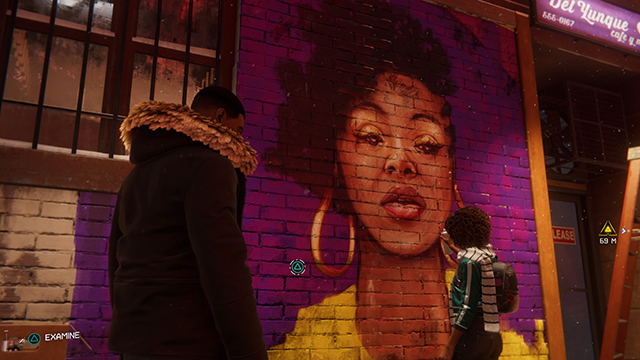
Miles’ story is a heartfelt one. Picking up a year after the events of Marvel’s Spider-Man, he’s first seen swinging around Harlem with his mentor Peter Parker. He hasn’t quite adjusted to this new role, though he does show some promise. Moments in Miles prove that he can throw hands with the best of them, Parker included.
Still, he’s new to the game (heh) and needs all the help he can get. When things go wrong and a powerful villain is released from custody, it takes all of Parker’s “been there, done that” advice to snap Miles out of his self-doubting funk. From there, the story moves in earnest, with Miles stepping into the shoes of New York’s sole protector.
Spider-Man: Miles Morales has familiar story beats. Anyone who’s played through the first game will recognize the signs. An evil corporation hurts several people in pursuit of something, leading to the creation of a villain who ends up hurting everyone. Familial bonds are strained. Friendships are tested.
As things unravel, a few twists are revealed — some of which comic-book heads will see coming a mile away — before an ultimate showdown of sorts. Thankfully, that’s just the surface content.
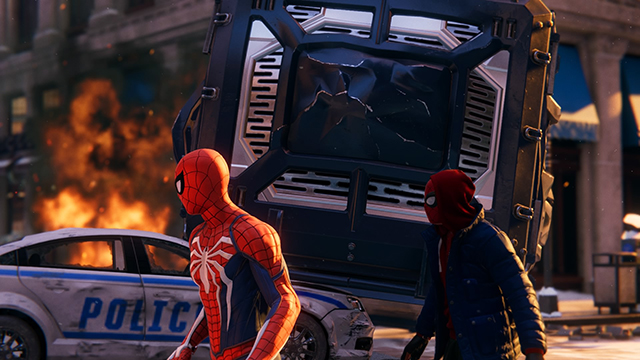
Looking a little deeper, one can find a story that explores what it means to be a family. It shows how shared experiences can create meaningful relationships, the destructive nature of a well-meaning lie, the power of forgiveness, and how far a person will go to protect a loved one. All of this is showcased through an awesome cast of characters and solid voice work.
Whether it’s Miles, his loving mother Rio Morales, or Ganke Lee, Miles’ “man in the chair” and best male friend, the audience is always in for a treat. That goes double for the game’s main villain. They steal the show whenever on screen, delivering equal amounts of sadness and rage, easily making them one of the best antagonists seen this year.
Again, Miles’ story is heartfelt. It’s also succinct. Some might gawk at this game’s price because of a short campaign, and there’s some validity to that, especially if this is the only game you’re buying in the near future. The thing is, the original Spider-Man could have used some edits.
As much as I loved seeing inventive versions of classic villains, the first game was a bit bloated. Spider-Man: Miles Morales moves with a sense of urgency and in doing so, delivers a better story — even when considering the similarities mentioned above — proving that less is actually more.
While Spider-Man: Miles Morales should be praised for its story, it does present a few sticking points when it comes to representation, namely in how it handles systemic issues facing black and brown people. To be blunt: Insomniac fails in this regard. If Miles’ story only centered on him becoming a bonified hero, it would be easier to overlook. But it’s clear that Insomniac wanted to address issues of race — just from a safe distance.
The game doesn’t take a real stand on racial issues. Nor does it directly talk about the difficulties Miles might face being Afro-Latino in New York. Instead, Insomniac offers lip service. A Black Lives Matter sign does nothing when it isn’t met with action. In this case, there isn’t even a passing remark or event showing the reality of being a black vigilante.
There is a very brief moment — insert Roxxon soldiers in place of the police — but it’s stuck in the fantastical. If Miles was a real-life superhero… well, let’s just say he’d have a harder time than Peter Parker.
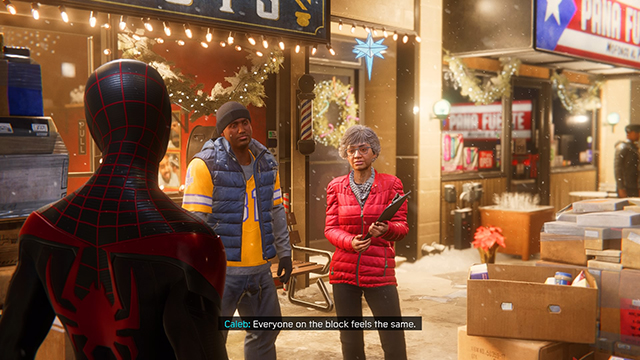
This isn’t entirely Insomniac’s fault. Marvel has dropped the ball several times in the past as well. Bright moments, like Tony Stark talking to Miles about what it feels like to be profiled during Civil War 2, are overshadowed by Miles declaring he doesn’t want to be known as the “black Spider-Man” after a tense encounter with police.
Writing this sort of thing takes a careful hand, is my point. And considering Brian Bendis, the creator of Miles Morales, often stumbled in this regard, I can cut Insomniac some slack, especially since they got everything else right.
When it comes to showcasing Miles Morales’ culture, Insomniac knocks it out of the park. The game is filled with mostly positive representations of black and brown people. Puffy coats, Tims, loose-fitting jeans during the winter. Bilingual conversations, the slang, Hip Hop, sports poster with a variation of Jordan dunking, and the collective spirit of people living in Harlem.
I loved it when Miles signed to his deaf friend, commending her on her Spider-Man mural. There’s just a lot to take in as a black person, most of which helped provide a nuanced perspective leading up to a grand experience.
Of course, these elements are book-ended by superheroes and villains. Megacorporations and shady dealings. It’s basically Marvel’s world but seen from our side of the tracks. And the view is beautiful!
Streamlined Approach
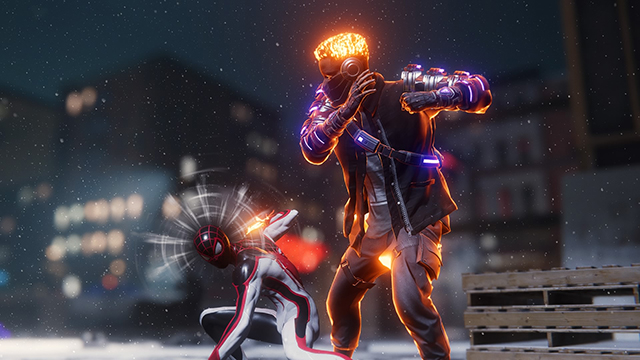
Marvel’s Spider-Man: Miles Morales features a streamlined edition of the gameplay found in the 2018 original. Players can still beat the snot out of criminals by bouncing from foe to foe, occasionally using “Spidey sense” to dodge attacks (think Batman Arkham) before following up with a counter.
Consecutive hits eventually send enemies flying while, conversely, holding down the attack button will launch them into the air. From there, they’ll be met with repeated punches to the face, a swinging kick, or be slammed back onto the ground with well-placed webbing.
Miles is just as fast as Peter. Because of this, pulling off wild combos is always entertaining; his speed and strength allow for some impressive moments in battle. Miles stands a bit better than Peter mechanically, though. For one, all of the abilities that players had to unlock in the first game are granted to Miles from the start. Basic stuff like being able to web away weapons from enemies and toss those weapons back at them are available from the start.
Even traversal abilities aren’t held behind experience levels; most of Miles’ skill trees are devoted to meaningful upgrades instead of skills that we’d expect him to know already.
Also gone are the special skills found in various costumes/Spidey suits. They still unlock interesting perks by way of swappable Visor mods, but the big room-clearing moves are unique to Miles. Tied to his developing powers, he eventually unlocks cloaking abilities and Venom-based attacks.
The cloaking is great for sneaking up on enemies or when needing to exit a losing fight quickly. Miles’ Venom, on the other hand, is explosive. He can use it to knock away enemy shields, stun foes, destroy certain aspects of the environment, and solve electrical-based puzzles.
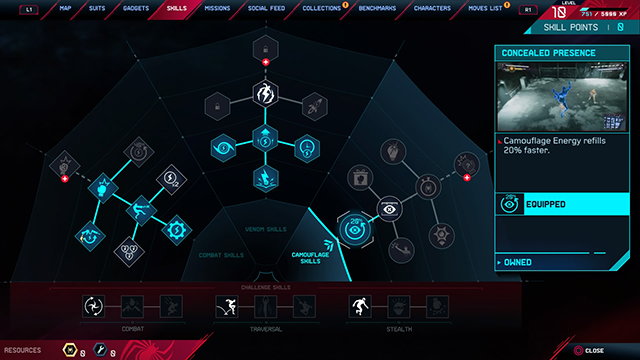
All of Miles’ skills are fun to use in and out of battle. What makes them great, though, is the fact that they don’t rely on suit-based technology. With the previous game, players had to swap special moves once unlocked; you couldn’t equip Web Blossom and Holo Decoy at the same time. That’s not the case in this game. As long as Miles has enough Venom — built up by attacking foes — Miles can use any of his unlocked Venom-based attacks whenever he wants.
This leads to another change. Players no longer have to worry about using Focus to heal themselves instead of activating finishers — flashy barrages that automatically subdue a given foe. When it comes to healing, Miles’ Venom gauges handles that. The finishers, on the other hand, are tied to combos. Score enough hits without taking damage and you’ll get the opportunity to take out an opponent with ease.
Another notable change comes via the stealthier side of things. Like Peter, Miles can web up unsuspecting enemies while perched on an elevated position within the environment. Unlike Peter, he can also mark enemies by scanning a given area. This allows Miles to keep tabs on people as he goes about clearing a room; their tags will persist even if they walk around a corner or behind a wall.
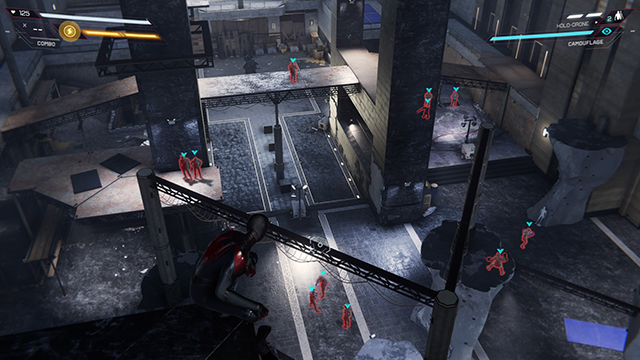
What all of these things equate to is a better combat experience. Aside from having most of his predecessor’s abilities at the start of the game, he also has access to all of his Venom powers (once unlocked) at any given moment. Throw in the Visor mods, invisibility, upgradable gadgets, and the ability to tag enemies, and it’s easy to see how more equipped Miles is for fighting.
This is, of course, balanced by the introduction of new foes and boss fights that require the proper use of certain skills. The game is still challenging, but it’s also way more entertaining to play.
Other streamlined elements include a better way to hunt down side quests and random crimes. Thanks to an app created by Ganke, people can reach Miles by posting current events. All you have to do is swipe left on the PS4/PS5’s touchpad, scroll through the different posts, and click on the one you want to follow up on to produce a way-marker.
The map is still there (you can go through the menus and tag a side quest the old fashion way), but using the app proved to be much faster. And speaking of the map, there are no towers to hack. The entire city is open/populated with relative icons, with areas only greyed out because you aren’t in them.
Visuals
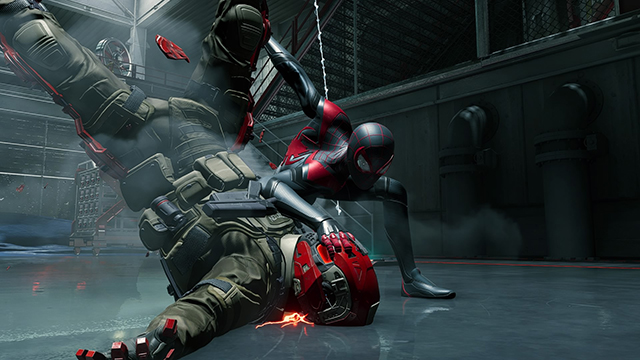
It’s no secret that the PS5 version of Marvel’s Spider-Man: Miles Morales looks better than the PS4 version, especially when it comes to the finer details — boot prints in the snow, various metals and fabric, Miles’ haircut — and the ability to toggle between Fidelity and Performance modes.
That said, the PS4 version (the one I’m reviewing) looks great. Swinging through the city is still exhilarating. And the load times are negligible; I didn’t experience any pop-ins or issues concerning quick transitions from interior to exterior spaces and vice versa.
Honestly, the only bad thing I can say is that its next-gen version looks better. But that’s to be expected.
Marvel’s Spider-Man: Miles Morales Review — The Bottom Line
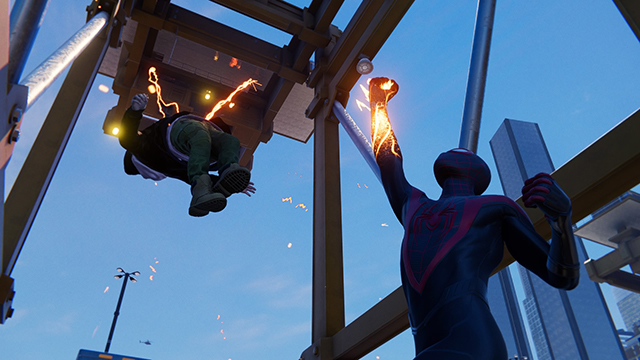
Pros
- Solid representation
- Succinct, well-written story
- Elevated/streamlined combat and game mechanics
- Dope soundtrack
- Excellent voice acting
Cons
- BLM lip service
- Looks better on PS5
I could spend days talking about why I had a blast playing as Miles. As someone who recently beat the first game (to get ready for this one), I can confidently say that Spider-Man: Miles Morales is better than its predecessor in almost every way. The combat, streamlined UI, story, and overall game length is damn near perfect. And that’s just on more gamey aspects.
It’s also close to being perfect when it comes to representation. Black and brown people fill out most of the roles and do so with gusto. Their performances, at times, eclipsing what came before. I’m thoroughly pleased with what Insomniac has accomplished.
Hopefully, if Miles gets another go, they won’t be afraid to tackle the tough issues he faces as an Afro-Latino superhero.
[Note: Sony provided the copy of Spider-Man: Miles Morales used for this review.]










Published: Nov 18, 2020 07:37 pm